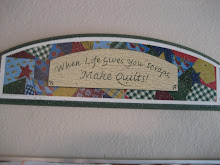

When I came up with the idea of making quilts, I didn't really consider the process of how a quilt is made and the training involved. I have been doing it for so many years it seems natural for me. However for those who have never made a quilt it can be very intimidating. I have worked hard in simplifying the process for our vendors. I have chosen a pattern with all straight lines, minimal cutting and easy piecing. Thank God, I have my husband, Buzz, to help with all the calculating of fabric yardage needed to make the quilts in bulk.
To make a quilt the fabric has to be cut into strips,. The strips are sewed together, and then re cut into units. The units are sewed to make the repeat pattern otherwise known as the block. Once you have enough blocks made, they are sewed together to make the quilt top. The final step of the quilt top is adding the outer borders. Once the quilt top is finished you layer the top, batting and backing fabric like a sandwich and quilt these layers together. After quilting, the label is put on the back and the raw edges bound. So far our vendors have understood the process. Buzz and I have gotten many compliments on how well we have broken down the steps, with illustrations and examples for them to follow. They wish all their customers did the same.
The cutters and sewers were excited when the first test top was finished. At last they could see what all these pieces were going to look like as a whole. Production is moving along. The quilt tops are in the sewing stage. By the end of June they should be ready for quilting. The next few weeks I hope to have hired a couple of long arm quilters who will quilt and "write" the phrases in the white middle border. (see picture) I have some people in mind and it's a matter of working out some of the details. I am still having trouble finding the wide flannel that I would like to use for the backing of the quilt. I hope I do not have to fall back on a cotton fabric for the back. Flannel backs are so warm and cuddly.
After the quilts are quilted the next step is to attach a label to the back of the quilt. The label is an important part of any quilt just like a signature with a date is for a painting. At a minimum it states who the quilt belongs to, who made it and date. That way the quilt can be handed down to the next generation with a documented history. I am thinking of using an iron fuse fabric or maybe a transfer material instead of sewing the label. I am open to suggestions. If I use a transfer material, I can create a "picture" of a label, edit it with names and date, and then print it out on the transfer material, iron the transfer onto the back of the quilt. The process being similar to making t-shirts. I have to work on that. Otherwise the label needs to be sewn into the borders and tacked down so it wont tear away. If I have it sewn, it could be labor intensive. Each quilt would have it's own personal label. Trying to keep things simplified is difficult to do.
We still need to find out what the State of Texas Textile laws are for blankets. I know we need a material and care instruction label but I don't know if we need non-flammable batting. I went to a craft fair and spoke to someone selling her quilts. She did not have any care/material label and never worried about the non-flammable batting. HMMMM?
Looking forward to 2011 is very exciting. I have already started planning on making a quilt for men and children. Plus I am designing an "Americana" quilt for the armed services, police, and fire department heros.
It is occurring to me that people who purchase these quilts may not have a life threatening condition or may not know anyone who is. They just want a quilt that speaks to them. That's great too! The more quilts that are sold the more funding goes to medical research, programs, and education. I figured that if I sell 500 quilts in a year, I could donate $30,000 towards cures and preventions. Wouldn't that be amazing?!
In health,
Robyn
"Robyn's Gift" mission is to provide relief from the trauma associated with life threatening illnesses.


Wow, just wow!! My sister is also a quilter and can't actually remember the "learning process" of quilting, she's been doing it so long. I just LOVE the way they look, but am so overwhelmed everytime I try to learn how to make them. I think you both are incredible artists!!
ReplyDelete